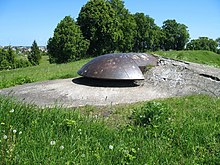Ninth Fort


The Ninth Fort (Lithuanian: Devintas Fortas) is a stronghold in the northern part of Šilainiai elderate, Kaunas, Lithuania. It is a part of the Kaunas Fortress, which was constructed in the late 19th century. During the occupation of Kaunas and the rest of Lithuania by the Soviet Union, the fort was used as a prison and way-station for prisoners being transported to labour camps. After the occupation of Lithuania by Nazi Germany, the fort was used as a place of execution for Jews, captured Soviets, and others.
History


At the end of 19th century, the city of Kaunas was fortified, and by 1890 it was encircled by eight forts and nine gun batteries. The construction of the Ninth Fort (its numerical designation having stuck as a proper noun) began in 1902 and was completed on the eve of World War I. From 1924 on, the Ninth Fort was used as the Kaunas City prison.
During the years of Soviet occupation, 1940-1941, the Ninth Fort was used by the NKVD to house political prisoners on their way to the labour camps in Siberia.
During the years of Nazi occupation, the Ninth Fort was put to use as a place of mass murder. At least 5,000 Lithuanian Jews of Kaunas, largely taken from the city's Jewish ghetto, were transported to the Ninth Fort and killed. In addition, Jews from as far as France, Austria and Germany were brought to Kaunas during the course of Nazi occupation and executed in the Ninth Fort. In 1944, as the Soviets moved in, the Germans liquidated the ghetto and what had by then come to be known as the "Fort of Death", and the prisoners were dispersed to other camps. After the World War II, the Soviets again used the Ninth Fort as a prison for several years. From 1948 to 1958, farm organizations were run out of the Ninth Fort.
In 1958, a museum was established in the Ninth Fort. In 1959, a first exposition was prepared in four cells telling about Nazi war crimes carried out in Lithuania. In 1960, the discovery, cataloguing, and forensic investigation of local mass murder sites began in an effort to gain knowledge regarding the scope of these crimes.
Museum
The Ninth Fort museum contains collections of historical artifacts related both to Soviet atrocities and the Nazi genocide, as well as materials related to the earlier history of Kaunas and Ninth Fort.
The memorial to the victims of Nazism at the Ninth Fort in Kaunas, Lithuania, was designed by sculptor A. Ambraziunas. Erected in 1984, the monument is 105 feet (32 m) high. The mass burial place of the victims of the massacres carried out in the fort is a grass field, marked by a simple yet frankly worded memorial written in several languages. It reads, "This is the place where Nazis and their assistants killed more than 30,000 Jews from Lithuania and other European countries."
External links
- Kaunas' 9th fort Museum
- Kaunas Ninth Fort Web Page by Jose Gutstein
